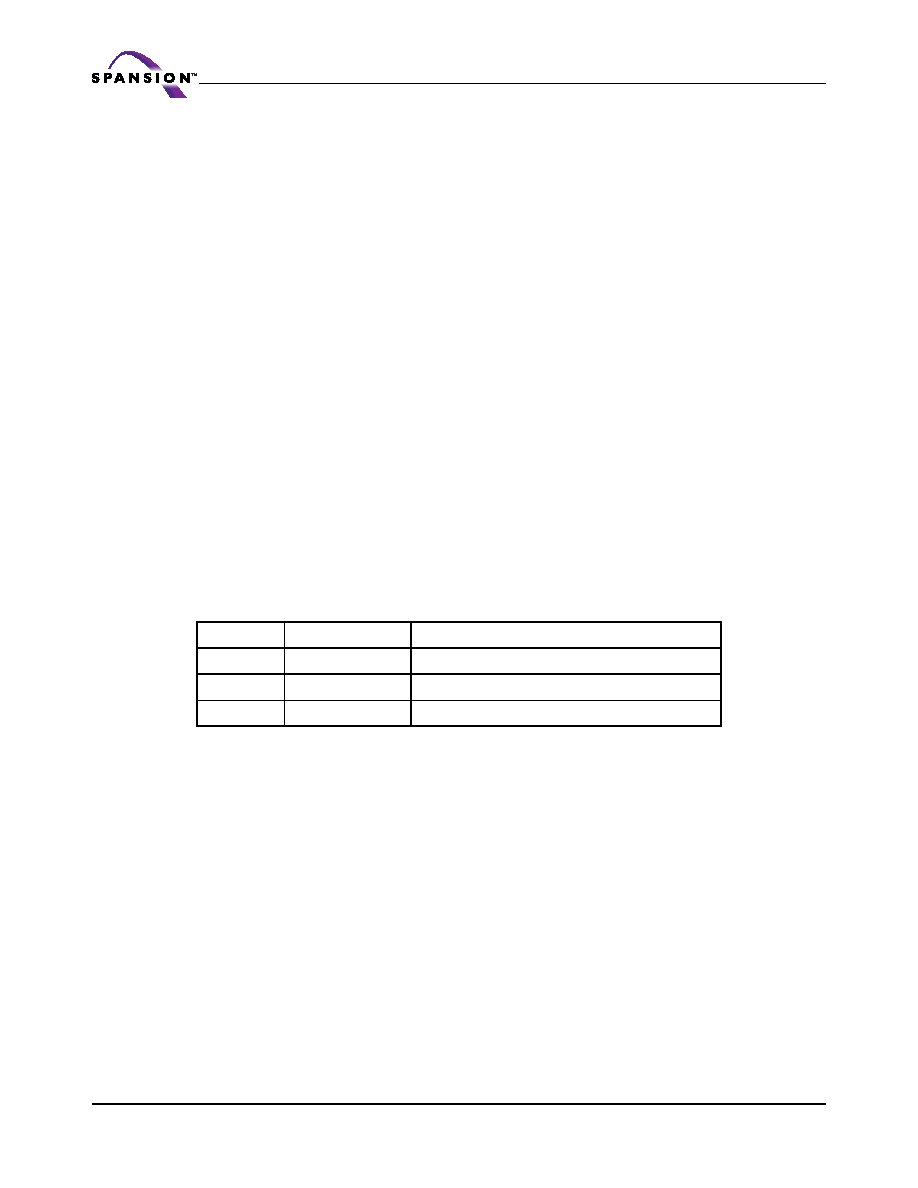- 您現(xiàn)在的位置:買賣IC網(wǎng) > PDF目錄225141 > S29WS064N0PBAW011 (Spansion Inc.) 256/128/64 MEGABIT CMOS 1.8 VOLT ONLY SIMULTANEOUS READ/WRITE BURST MODE FLASH MEMORY PDF資料下載
參數(shù)資料
| 型號: | S29WS064N0PBAW011 |
| 廠商: | Spansion Inc. |
| 英文描述: | 256/128/64 MEGABIT CMOS 1.8 VOLT ONLY SIMULTANEOUS READ/WRITE BURST MODE FLASH MEMORY |
| 中文描述: | 256/128/64兆位的CMOS 1.8伏只有同時(shí)讀/寫突發(fā)模式閃存 |
| 文件頁數(shù): | 19/99頁 |
| 文件大小: | 1091K |
| 代理商: | S29WS064N0PBAW011 |
第1頁第2頁第3頁第4頁第5頁第6頁第7頁第8頁第9頁第10頁第11頁第12頁第13頁第14頁第15頁第16頁第17頁第18頁當(dāng)前第19頁第20頁第21頁第22頁第23頁第24頁第25頁第26頁第27頁第28頁第29頁第30頁第31頁第32頁第33頁第34頁第35頁第36頁第37頁第38頁第39頁第40頁第41頁第42頁第43頁第44頁第45頁第46頁第47頁第48頁第49頁第50頁第51頁第52頁第53頁第54頁第55頁第56頁第57頁第58頁第59頁第60頁第61頁第62頁第63頁第64頁第65頁第66頁第67頁第68頁第69頁第70頁第71頁第72頁第73頁第74頁第75頁第76頁第77頁第78頁第79頁第80頁第81頁第82頁第83頁第84頁第85頁第86頁第87頁第88頁第89頁第90頁第91頁第92頁第93頁第94頁第95頁第96頁第97頁第98頁第99頁

24
S29WS-N_00_G0 January 25, 2005
Adva nce
Information
VIL. Continuous burst mode can also be aborted by asserting AVD# low and providing a new ad-
dress to the device.
If the address being read crosses a 128-word line boundary (as mentioned above) and the sub-
sequent word line is not being programmed or erased, additional latency cycles are required as
reflected by the configuration register table (Table 7.8).
If the address crosses a bank boundary while the subsequent bank is programming or erasing,
the device provides read status information and the clock is ignored. Upon completion of status
read or program or erase operation, the host can restart a burst read operation using a new ad-
dress and AVD# pulse.
7.3.4 8-, 16-, 32-Word Linear Burst Read with Wrap Around
In a linear burst read operation, a fixed number of words (8, 16, or 32 words) are read from con-
secutive addresses that are determined by the group within which the starting address falls. The
groups are sized according to the number of words read in a single burst sequence for a given
mode (see Table 7.7).
For example, if the starting address in the 8-word mode is 3Ch, the address range to be read
would be 38-3Fh, and the burst sequence would be 3C-3D-3E-3F-38-39-3A-3Bh. Thus, the device
outputs all words in that burst address group until all word are read, regardless of where the start-
ing address occurs in the address group, and then terminates the burst read.
In a similar fashion, the 16-word and 32-word Linear Wrap modes begin their burst sequence on
the starting address provided to the device, then wrap back to the first address in the selected
address group.
Note that in this mode the address pointer does not cross the boundary that occurs every 128
words; thus, no additional wait states are inserted due to boundary crossing.
Table 7.7. Burst Address Groups
7.3.5 8-, 16-, 32-Word Linear Burst without Wrap Around
If wrap around is not enabled for linear burst read operations, the 8-word, 16-word, or 32-word
burst executes up to the maximum memory address of the selected number of words. The burst
stops after 8, 16, or 32 addresses and does not wrap around to the first address of the selected
group.
For example, if the starting address in the 8- word mode is 3Ch, the address range to be read
would be 39-40h, and the burst sequence would be 3C-3D-3E-3F-40-41-42-43h if wrap around
is not enabled. The next address to be read requires a new address and AVD# pulse. Note that
in this burst read mode, the address pointer may cross the boundary that occurs every 128 words,
which will incur the additional boundary crossing wait state.
7.3.6 Configuration Register
The configuration register sets various operational parameters associated with burst mode. Upon
power-up or hardware reset, the device defaults to the asynchronous read mode, and the config-
uration register settings are in their default state. The host system should determine the proper
settings for the entire configuration register, and then execute the Set Configuration Register
command sequence, before attempting burst operations. The configuration register is not reset
after deasserting CE#. The Configuration Register can also be read using a command sequence
(see Table 12.1). The following list describes the register settings.
Mode
Group Size
Group Address Ranges
8-word
8 words
0-7h, 8-Fh, 10-17h,...
16-word
16 words
0-Fh, 10-1Fh, 20-2Fh,...
32-word
32 words
00-1Fh, 20-3Fh, 40-5Fh,...
相關(guān)PDF資料 |
PDF描述 |
|---|---|
| S29WS128N0LBFI111 | 256/128/64 MEGABIT CMOS 1.8 VOLT ONLY SIMULTANEOUS READ/WRITE BURST MODE FLASH MEMORY |
| S29WS128N0LBFI112 | 256/128/64 MEGABIT CMOS 1.8 VOLT ONLY SIMULTANEOUS READ/WRITE BURST MODE FLASH MEMORY |
| S29WS128N0LBFI113 | 256/128/64 MEGABIT CMOS 1.8 VOLT ONLY SIMULTANEOUS READ/WRITE BURST MODE FLASH MEMORY |
| S29WS128N0LBFW011 | Test Clip; Current Rating:100A; Body Material:Steel; Features:Unmarked; Jaw Opening Max:1.625"; Overall Length:6" RoHS Compliant: NA |
| S29WS128N0LBFI011 | 256/128/64 MEGABIT CMOS 1.8 VOLT ONLY SIMULTANEOUS READ/WRITE BURST MODE FLASH MEMORY |
相關(guān)代理商/技術(shù)參數(shù) |
參數(shù)描述 |
|---|---|
| S29WS064N0PBAW012 | 制造商:SPANSION 制造商全稱:SPANSION 功能描述:256/128/64 Megabit (16/8/4 M x 16-Bit) CMOS 1.8 Volt-only Simultaneous Read/Write, Burst Mode Flash Memory |
| S29WS064N0PBAW013 | 制造商:SPANSION 制造商全稱:SPANSION 功能描述:256/128/64 MEGABIT CMOS 1.8 VOLT ONLY SIMULTANEOUS READ/WRITE BURST MODE FLASH MEMORY |
| S29WS064N0PBAW110 | 制造商:SPANSION 制造商全稱:SPANSION 功能描述:256/128/64 MEGABIT CMOS 1.8 VOLT ONLY SIMULTANEOUS READ/WRITE BURST MODE FLASH MEMORY |
| S29WS064N0PBAW111 | 制造商:SPANSION 制造商全稱:SPANSION 功能描述:256/128/64 MEGABIT CMOS 1.8 VOLT ONLY SIMULTANEOUS READ/WRITE BURST MODE FLASH MEMORY |
| S29WS064N0PBAW112 | 制造商:SPANSION 制造商全稱:SPANSION 功能描述:256/128/64 MEGABIT CMOS 1.8 VOLT ONLY SIMULTANEOUS READ/WRITE BURST MODE FLASH MEMORY |
發(fā)布緊急采購,3分鐘左右您將得到回復(fù)。